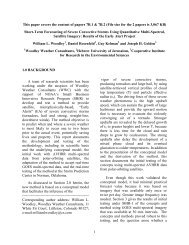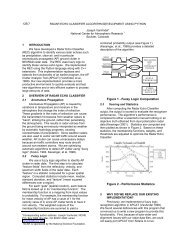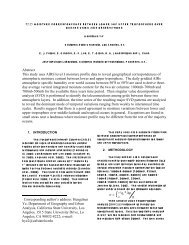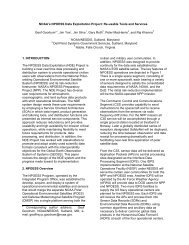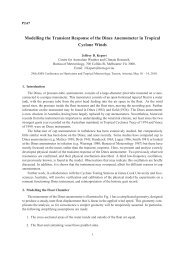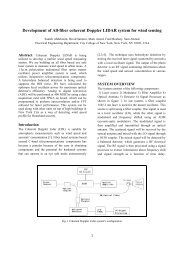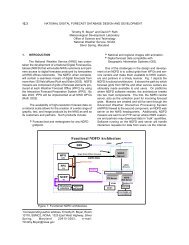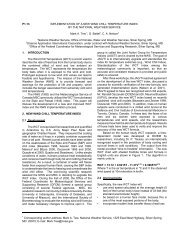Extended Abstract - AMS supported meetings
Extended Abstract - AMS supported meetings
Extended Abstract - AMS supported meetings
Create successful ePaper yourself
Turn your PDF publications into a flip-book with our unique Google optimized e-Paper software.
3B.1 PREVALENCE OF WEATHER SENSITIVITY IN GERMANY<br />
P. Höppe*. S. von Mackensen + . D. Nowak*. E. Piel #<br />
*Institute und Outpatient Clinic for Occupational and Environmental Medicine.<br />
Ludwig-Maximilians-University. Munich. Germany<br />
+ Institute for Medical Psychology. Ludwig-Maximilians-University. Munich. Germany<br />
# Institut für Demoskopie. Allensbach. Germany<br />
1. INTRODUCTION<br />
The often used term “weather sensitivity” (WS)<br />
has never been defined scientifically and is<br />
used colloquially with many different<br />
meanings. Generally it describes weather<br />
related incidences of symptoms and diseases.<br />
For some decades the syndrome of WS can<br />
be found in biometeorological publications<br />
(e.g. Jendritzky, 1993), many of them<br />
published in German language and often not<br />
peer reviewed journals. During the last ten<br />
years there seems to be an increase of<br />
interest in the topic of WS on an international<br />
level (Jamisom et al., 1995; Aikmann, 1997;<br />
Schienle et al., 1998; Falkenbach et al., 1998;<br />
Ranner and Egger, 1998).<br />
By now most of the studies on weather effects<br />
on humans are descriptive. They are limited to<br />
calculations of correlations between meteorological<br />
parameters and physiological or<br />
pathological end points. Through these<br />
studies, it is certainly proved, that at definite<br />
weather situations, there are significant effects<br />
on well-being (Jendritzky, 1992; Bucher und<br />
Haase, 1993), measurable changes of blood<br />
pressure (Höppe, 1982), increases of<br />
postoperative complications (Eberhart et al.,<br />
2000) and even of mortality (Jendritzky, 1998;<br />
Kalkstein, 1991; Danet et al.,1998). In general<br />
5 to 25 % of the variance in health endpoints<br />
can be explained by weather factors, in<br />
subjective complaints sometimes more than<br />
50 % (Jendritzky, 1992).<br />
_____________________________________<br />
* Corresponding author address:<br />
PD Dr. Peter Höppe<br />
Institute and Outpatient Clinic for Occupational and<br />
Environmental Medicine, Ziemssenstr. 1. D-80336<br />
München, Germany. Email:<br />
phoeppe@arbeits.med.uni-muenchen.de<br />
There are also some studies, which show<br />
strong non trivial associations (e.g. not caused<br />
by icy roads or storm) between weather and<br />
industrial and traffic accidents (Rauschhofer et<br />
al., 1981; Jendritzky, 1978). Until now,<br />
however, there is a lack of studies, that can<br />
prove causal relations. As basis for such<br />
studies it is helpful to first collect comprehensive<br />
information on the prevalence and<br />
symptom patterns of WS in a whole<br />
population. To fill this gap we carried out a<br />
representative WS census in January 2001 in<br />
Germany.<br />
2. METHODS<br />
We developed a questionnaire with six<br />
questions on the subjectively perceived<br />
prevalence of WS, its most common<br />
symptoms and the associated weather<br />
patterns. These questions were integrated into<br />
a routine multi-topic questionnaire of a census<br />
agency (Institut für Demoskopie Allensbach).<br />
The sample consisted of 1,064 German<br />
citizens older than 16 years. The results were<br />
weighted representatively for the whole<br />
German population in respect to age, gender,<br />
residential characteristics, professional status,<br />
marital status and family size. The trained<br />
interviewers were instructed to read the<br />
questions literally and always in the same<br />
order. The interviews were made between<br />
January 5 th and 16 th , 2001.<br />
3. RESULTS<br />
19.2% of the interviewed persons report a<br />
“strong influence” of weather on their health,<br />
35.3% a “slight influence”. Hence, 54.5% see<br />
some kind of association between weather<br />
and health. In the following, both groups (slight<br />
influence and strong influence) are called
“weather sensitive”. Women are significantly<br />
overrepresented in the group of „strong<br />
weather influence“ (28.0 %) compared to men<br />
(9.6%). The prevalence of strong WS<br />
increases with age from 11% in the group 16-<br />
29 years to 32% in the group >60 years. The<br />
largest relative difference between men and<br />
women is found in the youngest group with<br />
only 2% of the male but 21% of the female<br />
subjects.<br />
The following results only refer to those<br />
subjects, who have stated to be weather<br />
sensitive (n=583). Overall the highest<br />
frequencies of weather related symptoms are<br />
reported for days with stormy weather (30%)<br />
and, when it gets colder (29%). A striking<br />
difference between Southern and Northern<br />
Germans was, that in Bavaria 30.1% of the<br />
WS subjects have symptoms on days with<br />
advection of warm air (only 18.8 % at cold air<br />
advection) while in Northern Germany this<br />
fraction only is about 10 %. This points to the<br />
important role of Foehn weather in Bavaria for<br />
WS. As to be expected, the least rates of WS<br />
complaints are found for days with nice<br />
weather (5.5%). One quarter (25.4%) of the<br />
interviewed people stated to have experienced<br />
their WS for the first time in the age range<br />
between 20 to 30 years.<br />
In one question we asked the subjects for the<br />
kind of WS symptoms they predominantly<br />
develop. The question listed 20 different<br />
symptoms and health disorder, which have<br />
been been mentioned in scientific publications<br />
in connection with weather changes. The most<br />
frequent symptoms reported by the weather<br />
sensitive subjects are headache/migraine<br />
(61%), exhaustion (47%), sleep disturbances<br />
(46%), fatigue (43%), joint pain (40%),<br />
irritation (31%), depression (27%), vertigo<br />
(26%) and scar pain (23%). While for<br />
headache the highest prevalence is reported<br />
in the age group 30-44 years for joint pain<br />
there is a steady increase with age reaching<br />
more than double the values in the group >60<br />
years (66%) compared to all other age groups.<br />
In order to get more information on the<br />
severity of a potentially weather related<br />
influence on health and its socio-economic<br />
meaning, we asked the subjects if they<br />
suffered that much from their weather<br />
sensitivity at least once during the last year<br />
that they were incapable to do their regular<br />
work (for example job or household). For 32%<br />
of the WS subjects this was the case, 22% of<br />
them even reported that they could not do their<br />
regular work on more than one occasion. On<br />
average 10.2 days of temporary disablement<br />
due to weather effects was stated.<br />
In the next question we asked the subjects, if<br />
they had one or more chronic diseases listed<br />
in the questionnaire. The most prevalent<br />
chronic diseases were heart/circulatory<br />
disturbances (24.4%) and allergies (20.5%).<br />
11.5% reported hay fever, 10.9% rheumatism.<br />
10.5% of the individuals had chronic diseases<br />
of the respiratory tract, 9.3% heart diseases<br />
and chronic pain. The prevalence of allergies<br />
showed a clear difference between West<br />
(22.1%) and East Germany (14.2%).<br />
Circulatory disturbances were mostly reported<br />
by subjects in the age group >60 years<br />
(42.6%), whereas allergies were most frequent<br />
in the age group between 30 and 44 years.<br />
Comparing the co-morbidities of weather<br />
sensitive subjects with those not being<br />
weather sensitive, shows clearly, that chronic<br />
diseases are significantly more prevalent in<br />
the group of the weather sensitive subjects.<br />
For almost all diseases listed in the<br />
questionnaire with only one exception (throatnose-ear<br />
diseases) the prevalence is much<br />
higher in the WS group (see tab. 1). The<br />
largest differences are found for circulatory<br />
diseases and rheumatism (ORs 7.1 resp. 2.9,<br />
adjusted for age). These results back the<br />
hypothesis, that weather associated symptoms<br />
especially concern people with pre-morbidity.<br />
This also seems to be the reason why the<br />
group of elderly show the highest WS<br />
prevalence rates.<br />
4. DISCUSSION AND OUTLOOK<br />
The results from the German WS survey have<br />
demonstrated the high prevalence of<br />
subjectively perceived influences of weather<br />
on health. The comparison of the results for<br />
the whole collective with data from a Federal<br />
Health Survey (Hermann-Kunz, 1999;<br />
Thefeld,1999) provides good corresponding<br />
results for the prevalences of allergies<br />
(20.7%), hay fever (15.4%), asthma (5.6%)<br />
and diabetes (5.5%). This can be taken as a
hint that the results of our interviews can be<br />
really considered as representative.<br />
There are many studies which have also<br />
proven that besides such subjective assessments<br />
there objectively are associations<br />
between the incidence of a multitude of WS<br />
symptoms and certain weather situations (e.g.<br />
Bucher and Haase, 1993). The still missing<br />
links are the determination of the causal<br />
agents and the understanding of the<br />
physiological processes.<br />
Two years ago an interdisciplinary working<br />
group was founded by our institute to develop<br />
research projects on causal agents of WS.<br />
The data of the questionnaire presented above<br />
are an important basis for these studies. The<br />
first activity of the working group was to define<br />
the new term ARS (Atmosphere Related<br />
Syndrome) to replace the never properly<br />
defined colloquial term WS.<br />
Comorbidity in %<br />
Total<br />
(n=1064)<br />
Weather<br />
sensitive<br />
(n=581)<br />
Not weather<br />
sensitive<br />
(n=483)<br />
Odds Ratio<br />
(95%-CI)<br />
Circulatory disturbances 24.4 38.8 6.9 7.12<br />
(4.81-10.53)<br />
Allergies 20.5 26.2 13.6 2.70<br />
(1.94-3.77)<br />
Hay fever 11.5 12.7 10.0 1.67<br />
(1.12-2.48)<br />
Rheumatism 10.9 16.3 4.4 2.87<br />
(1.73-4.77)<br />
Diseases of the<br />
respiratory tract<br />
10.5 13.1 7.3 1.79<br />
(1.17-2.74)<br />
Heart diseases 9.3 12.9 4.9 1.87<br />
(1.13-3.10)<br />
Chronic pain 9.3 13.4 4.3 2.68<br />
(1.62-4.43)<br />
Skin diseases 9.2 10.8 7.3 1.67<br />
(1.07-2.59)<br />
Vascular diseases 8.5 11.5 4.9 1.87<br />
(1.13-3.11)<br />
Gastrointestinal diseases 7.2 8.7 5.4 1.48<br />
(0.90-2.44)<br />
Diabetes 6.6 8.3 4.5 1.30<br />
(0.76-2.23)<br />
Renal - bladderinflammation<br />
6.1 7.2 4.8 1.26<br />
(0.74-2.16)<br />
Ear, nose and throat 4.7 3.6 6.0 0.54<br />
inflammation<br />
(0.30-0.98)<br />
Liver-gall bladder<br />
diseases<br />
4.1 6.0 1.8 2.71<br />
(1.27-5.80)<br />
Asthma 3.4 4.0 2.7 1.20<br />
(0.59-2.42)<br />
Other diseases 12.7 16.1 8.6 1.93<br />
(1.30-2.85)<br />
Table 1: frequencies of co-morbidities of the whole population and the weather sensitive and not<br />
weather sensitive in comparison.
The definition of ARS is: “Changes of the<br />
physical, mental, emotional or social wellbeing<br />
and increases of the incidence or<br />
exacerbations of diseases, if they are related<br />
to changes of weather dependent atmospheric<br />
factors. Etiologically already known effects of<br />
air pollutants (for example irritation of the<br />
respiratory tract with ozone), UV-radiation (e.g.<br />
erythema) and of solely thermal genesis (e.g.<br />
cardio-circulatory insufficiency due to heat<br />
stress), are not regarded as ARS.<br />
Two atmospheric factors are in the focus of<br />
the new studies, i.e. atmospheric impulse<br />
radiation (sferics) and low frequency air<br />
pressure oscillations (APO). Both already fulfil<br />
most of the presuppositions to be causal<br />
agents for ARS. They have distinct weather<br />
associated patterns, they intrude into houses<br />
and there are first results of controlled<br />
exposure studies (with artificially generated<br />
sferics resp. APO) showing effects in humans<br />
(Delyukov and Didyk, 1999). In the case of<br />
APO there also already exists a hypothesis for<br />
the receptor, which could be the baroreceptor<br />
in the carotid sinus.<br />
5. LITERATURE<br />
Aikman A. The association between arthritis<br />
and the weather. Int J Biometeorol 1997;<br />
40(4):192-9.<br />
Bucher K, Haase C. Meteorotropy and<br />
medical-meteorological forecasts. Experientia<br />
1993; 49: 759-768.<br />
Danet S, Richard F, Montaye M, Beauchant S,<br />
Lemaire B, Graux C, Cottel D, Steclebout<br />
C, Marecaux N, Amouyel P. Unhealthy<br />
effects of outdoor temperature and<br />
atmospheric pressure on incidence.<br />
recurrence and mortality rates of<br />
myocardial infarction and coronary<br />
deaths. Proc. of Meeting of American<br />
Heart Association 1998; Dallas. Texas.<br />
USA.<br />
Delyukov A,. Didyk L. The effects of extra-lowfrequency<br />
atmospheric pressure<br />
oscillations on human mental activity. Int J<br />
Biometeorol 1999; 43: 31-37.<br />
Eberhart LHJ, Jakobi G, Winterhalter M,<br />
Georgieff M. Einfluss von Umweltfaktoren<br />
auf das Auftreten von Übelkeit und Erbrechen<br />
in der postoperativen Phase –<br />
Welchen Einfluss haben das Wetter und<br />
die Mondphasen? Anästhesiol Intensivmed<br />
Notfallmed Schmerzther 2000; 35:<br />
635-640.<br />
Falkenbach A, Schuh A, Wigand R. Pain in<br />
ankylosing spondylitis - the impact of the<br />
weather. Int J of Environmental Health<br />
Research 1198; 8:85-89.<br />
Herrmann-Kunz E. Häufigkeit allergischer<br />
Krankheiten in Ost- und Westdeutschland.<br />
Gesundheitswesen 1999; 61: 100-105.<br />
Höppe P. Tägliche Blutdruckvariabilität und<br />
Witterungsfaktoren. Wiss. Mitt. Meteorol.<br />
Inst Univ München 1982; 45: 72-81.<br />
Jamison RN, Anderson KO, Slater MA.<br />
Weather changes and pain: perceived<br />
influence of local climate on pain<br />
complaint in chronic pain patients. Pain<br />
1995; 61(2):309-15.<br />
Jendritzky G, Stahl T, Cordes H. Der Einfluss<br />
des Wetters auf das Verkehrsunfallgeschehen.<br />
Z. f. Verkehrssicherheit 1978;<br />
24: 119-127.<br />
Jendritzky G. Wirkungen von Wetter und Klima<br />
auf die Gesundheit des Menschen. In:<br />
Wichmann, Schlipköter, Fülgraff (Eds.).<br />
Handbuch der Umweltmedizin 1992;<br />
Ecomed Verlag. Landsberg.<br />
Kalkstein LS. A new approach to evaluate the<br />
impact of climate on human mortality.<br />
Environ Health Perspect 1991; 96: 145-<br />
150.<br />
Jendritzky G. The mortality/climate study of<br />
the Deutscher Wetterdienst. Preprints 13 th<br />
Conference on Biometeorology &<br />
Aerobiology et al. 1998; Albuquerque.<br />
<strong>AMS</strong>: 297-300.<br />
Ranner R, Egger JW. Das subjektive<br />
Wetterfühligkeitssyndrom. Psychologie in<br />
der Medizin 1998; 9 (4): 12-20.<br />
Rauschhofer H. Jendritzky G. Sönning W.<br />
Zusammenhang von Wetterfaktoren und<br />
Betriebsunfällen 1981: Respir Med 2000<br />
Jul;94(7):668-77<br />
Schienle A, Stark R, Vaitl D. Biological effects<br />
of very low frequency (VLF) atmospherics<br />
in humans: A review. J Scientific<br />
Exploration 1998. 12(3):455-468.<br />
Thefeld W. Prävalenz des Diabetes mellitus in<br />
der erwachsenen Bevölkerung Deutschlands<br />
Gesundheitswesen 1999; 61: 85-89.



